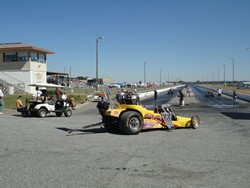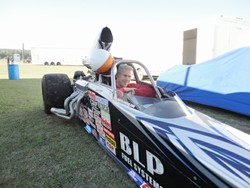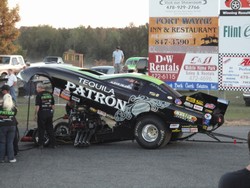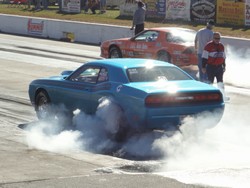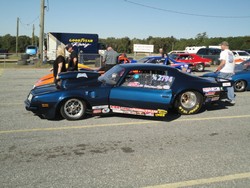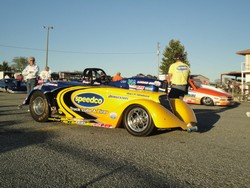 |
||
|
Racing with Uncle Sam A comparison between US and UK Sportsman racing by Paul Marston. Pictures by Tony Morris 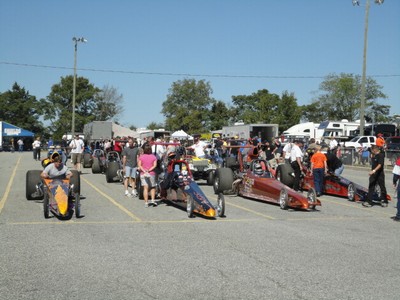
As many readers will know, Eurodragster.com sponsor Paul Marston is no stranger to racing in the NHRA. When Paul went on his latest US racing visit in the autumn of 2010 Eurodragster.com asked him to give us an insight into the differences between Sportsman racing in the USA and in the UK. Click on any picture for large version NHRA Divisional events may be similar to UK National Events number-wise, both numbering around seven, but how the events are run has evolved quite differently. Firstly the distances covered by the racers to attend these events are vast: out-of-Division racers can commonly travel 1000+ miles, and the sacrifices made by the racers to make the show are great. As a typical example, I was crewing with ex-pat Tony Morris and Charlie Boyd who run Super Comp and Top Dragster respectively. The weekend prior to this race Charlie had had a camshaft problem at the track; on Monday he pulled the motor and ordered a new camshaft, which was a special order item, through World Champion Comp racer Glen Treadwell. Glen had to pull some strings to have Comp Cams make it in time and Charlie collected it from Glen's shop on the Thursday morning. After working all day Thursday reassembling and fitting the 440 ci SB2 motor back in his dragster, Charlie, Tony and I set off at 10:00 pm from Brevard Cylinder Head on Merritt Island, Florida, for Silver Dollar Raceway in Reynolds, Georgia. Prior to that Tony and I had to shop for all the provisions - you have to take everything you need food- and drink-wise. More on that one later. Charlie drove all through the night with just one fuel stop and we arrived at 6:00 am...and this is considered a local race!
Once this is done you go to get tecched. The NHRA Lucas Oil Divisional safety staff tech the car. This is a simple check that all the safety equipment on the race car is up to date, that your licence is current, and that your race suit and helmet etc are in good condition. You are then issued with your run ticket. They do not scrutineer the race cars as is done in the UK. The reasoning is simple: it's your car and it's your responsibility to make sure that your car is safe. They will never know your car as well as you do, and after all it's your ass in it! As it was a Lucas Oil event the NHRA pretty much ran the show and the Silver Dollar track crew helped. The NHRA definitely have a no-nonsense attitude towards the racers and the racers know it, like the police over here you do not mess with them.
Having not raced in Super Pro in the US for four years, my licence has now lapsed; in NHRA you lose it if you do not compete every other year. I would have to re-licence, and in any case it only ever allowed me to drive a dragster as that's what I licenced in. If I wanted to cross over to a doorslammer I would have to do three perfect full passes for cross-licencing. Did I mention that you also would have to have a full medical every two years? For a non-American resident his is a tricky one. I personally obtained a dispensation so that I could take my medical in England. This speeds up the timeframe a little, although once you have been licenced you still cannot compete until you have posted your physical and signed-off licence to the NHRA in California to be issued an official licence and wait for them to post it back. Got that? At Silver Dollar Raceway there were around five hundred entries competing Super Street, Super Gas, Super Comp, Stock, Super Stock, Top Sportsman, Top Dragster, Comp, Top Alcohol Funny Car and Top Alcohol Dragster. There were no bike classes at all nor Super Pro ET and Pro ET. Top Sportsman (2003) and Top Dragster (2007) are both relatively new additions.
Track-wise, the Dollar can be tricky to read. I have been going there for six years now and it still catches racers out. The early morning mist has a lot of moisture and the atmospherics can play havoc with dialling-in. Surface-wise, it's totally different to what we have in England, it even feels different when you walk it. The traction was awesome at this event and changed very very little throughout the weekend. It is concrete up to the eighth mile which I guess is a major factor. Kicking off with Super Street bang on 11:00 am the event ran like a military operation. There were no pit marshals, the classes are called by the announcer over the radio and PA system. With much bigger staging lanes at American tracks - at the Dollar there are eight lanes each a hundred yards long - it's a pretty smooth process. You must not be late and you must not disrespect the staging lane marshals: no one does, you do what you are told. On each timed run a staging lane marshal clips your run card for that session so that they know that you made the call and to ensure that you can only run once. With so many cars in each class it's a simple yet effective system.
The racers themselves were deadly on the tree. If you did not put .00 or .01 on the Tree you were almost certainly going home. This I put down to the consistency of the surface and the sheer amount of racing opportunities that the racers have. Practice makes perfect and an average Sportsman racer in the US makes between two hundred and fifty and three hundred passes a year without pushing it. See my point? Comparing the Super classes to the UK, I always think that it's a fair comparison to say that we are around ten years behind the USA development-wise. This is definitely not a bad thing as some of the choices they have made and the paths that they have gone down have led to unique problems. Super Street is easily the most fun; their rules make it a class where all the old Super Gas cars go to retire so it's got some great race cars. It's their entry-level class and has some unique rules. Weight-wise you have to be minimum 2800 lbs so no Brogie or Corvette roadsters. This makes it a real level field so if you can win here you have earned it. With terminal speeds up to 140 mph, they are no slouches.
Super Comp as a class is devoid of doorslammers. You do get the occasional doorslammer or four-link altered but it's almost exclusively a dragster class, again with two throttle stops and terminal speeds up to 180 mph. Compared to Super Comp in the UK, where doorslammers still dominate, this is a stark contrast. Personally I doubt that you will see Super Comp go down this path in the UK, for many reasons which will take too long to explain! I always feel sorry for the guys who race in Stock, Super Stock and Comp. At every event two racers from each class are randomly picked and have to tear down their motors to have them checked out by the Tech guys to make sure that they are within the strict rules. Any racer who sets a new class record always has to tear down after the run, it's the rules.
Sunday morning started at 8:00 am with a service in the grandstand with Racers for Christ Division 2 Chaplain Tom Ratliff, who is a racer himself. It was a well-attended - remember America is a deeply-religious country - and good-natured service which was popular with the racing community. Another contrast was the fact that by and large Americans do not drink any alcohol. They drink gallons of sweet tea, which I personally cannot stand but they love it! Eliminations started at 9:00 am. The staging lanes were full, ready to go, then everything stopped. Tom led everyone on the property in prayer over the PA system and track radio, wishing everyone a safe and successful event, then the National Anthem was sung by a special guest. This was all taken very seriously and adhered to by everyone. The very moment the last note was sung, the engines started up and we were racing! Racing with Uncle Sam is different to racing in the UK. Having done both, I very enjoy racing in the USA as you can learn so much. The racers are so friendly and it's the people like Tony Morris who keep me coming back year after year. This reminds me of a moment which Tony and I shared during a long drive home from the race track. We were just talking about drag racing, the sacrifices you have to make and the challenges you have to overcome. I asked Tony "What keeps you going, drag racing over here is really hard work?". His answer was the same as mine: "I have no idea!". We both were laughing so hard that we nearly crashed the car... Tony Morris Racing web site Features and Interviews index Back to News page |
